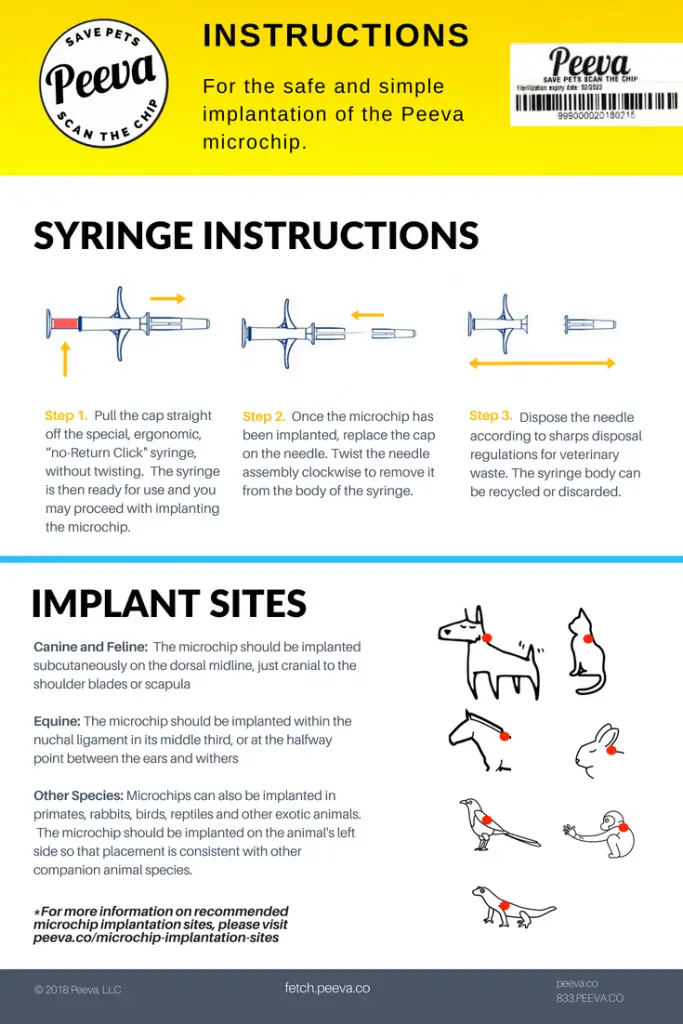How to implant a microchip
RFID and microchip technology has a lot of potential in resolving the pet epidemic. If microchips are registered and scanned properly they will work almost 100% of the time. As noted by WSAVA, issues pertaining to microchip technology (communication protocol) have been the thrust of standardization efforts in recent years; initially by microchip user groups and then through the International Standards Organization (ISO). Of equal importance to ISO standardization, standarization of microchip implantation sites is essential to the overall efficacy of RFID.
The following is to provide further information on recommended implantation sites for agricultural animals, other mammals, amphibians, avians and reptiles than the Peeva guide on the safe and simple implantation of the Peeva microchip that we distribute to our veterinary partners currently allows. Here we provide more details by variations of species and geography (as recommended by the World Small Animal Veterinary Association WSAVA where the following information was obtained) as well as the recommended implantation sites for agricultural animals, other mammals, amphibians, avians and reptiles.
Microchip implantation sites for small (companion) animals
Canine and FelineIn the canine and feline, there are two currently recognized implantation sites in use:
- The transponder (microchip) is implanted subcutaneous on the dorsal midline just cranial to the shoulder blades or scapula. This is the standard implantation site in all countries (including the United Kingdom [Wales, Scotland, England, and Northern Ireland] and the Republic of Ireland) excluding those of Europe.
- The transponder (microchip) is implanted subcutaneously in the midway region of the left neck. This is the standard implantation site in continental Europe (excluding the United Kingdom and the Republic of Ireland – see above).Until one common global site can be agreed upon, it is imperative that scanning concentrate on the implantation site commonly used in that geographic locale. Should an animal scan negative, it is strongly recommended that the alternative site in use, as defined above, also be scanned.
Recommended implantation sites in other species of animals
In bilaterally symmetrical species, microchips should be implanted on the left side (unless used as an aid in the identification of sex – in this case males are implanted on the left, females on the right where applicable).
Mammals
Equine
- In the equine, there are two recognized implantation sites currently in use
- The microchip is implanted within the nuchal ligament in its middle third or at the halfway point between the ears and the withers. This is the recommended implantation site in all countries except Australia.
The microchip is implanted in the musculature of the left neck or the anterior injection triangle. Clipping of the hair, local anaesthetic and aseptic technique is required. This is the recommended implantation site in Australia. Due to the use of two implantation sites, please review and follow the scanning procedures as discussed previously under canine and feline.Agricultural Animals - The implantation site for the bovine, ovine, porcine and caprine or other species used for meat production is subcutaneously at the base of the left ear on the scutiform cartilage. It is strongly recommended that any implanted food producing animal should carry an external identifier to indicate that a microchip is present so that it can be recognised and recovered at slaughter. Local trade or government guidelines must govern the use of implanted microchips in food producing species as in some situations their use may not be permitted.
Elephants
- Subcutaneously on the left side of the tail in the main caudal fold.
Hyrax and Loris
- Subcutaneously on the left side of the intralumbar area.
Alpacas (as per Australia)
- Subcutaneously midway on the left neck of top of the head behind the left ear.Other mammals
If the adult length is >17 cm from the backbone (spine) to the shoulder blade – subcutaneously at the base of the left ear. If <17 cm – subcutaneously between the shoulder blades.Amphibians
The microchip is to be implanted into the lymphatic cavity. The implantation site should be sealed with tissue glue.
Avians
- >5.5 kg adult weight and/or long-legged: subcutaneously at the base of the neck. <5.5 kg. adult weight: intramuscularly in the left pectoral muscle. Direct the implanter in a caudal (downward) direction. Use tissue glue and digital pressure or a suture to seal the implantation site.
Exceptions
Ratites
- Up to four days old – implanted in the piping muscle behind the head on the left.
Older birds
- Subcutaneously in the left thigh.
Emu
- Implanted in the dorsal midline in the s/c lump (Australia).
Penguins and vultures
- Subcutaneously at the base of the neck.
Fish
- >30 cm in length: on the left side at the anterior base of the dorsal fin. <30 cm in length: on the left side into the coelomic cavity.
Reptiles
Chelonians
- Left hind limb socket. Use a subcutaneous site in small chelonians, an intramuscular technique in large species as well as small species with thin skin. The implantation site should be sealed with tissue glue. Hibernating species should be implanted several weeks before the end of their active season in order to allow healing before hibernation.
Crocodilians
- Subcutaneously anterior to the nuchal cluster.
Lizards
- >12.5 cm snout to vent length – subcutaneously in the left inguinal region. <12.5 cm snout to vent length – intracoelomic.
Snakes
- Subcutaneously on the left side of the neck, twice the length of the head from the tip of the nose.




